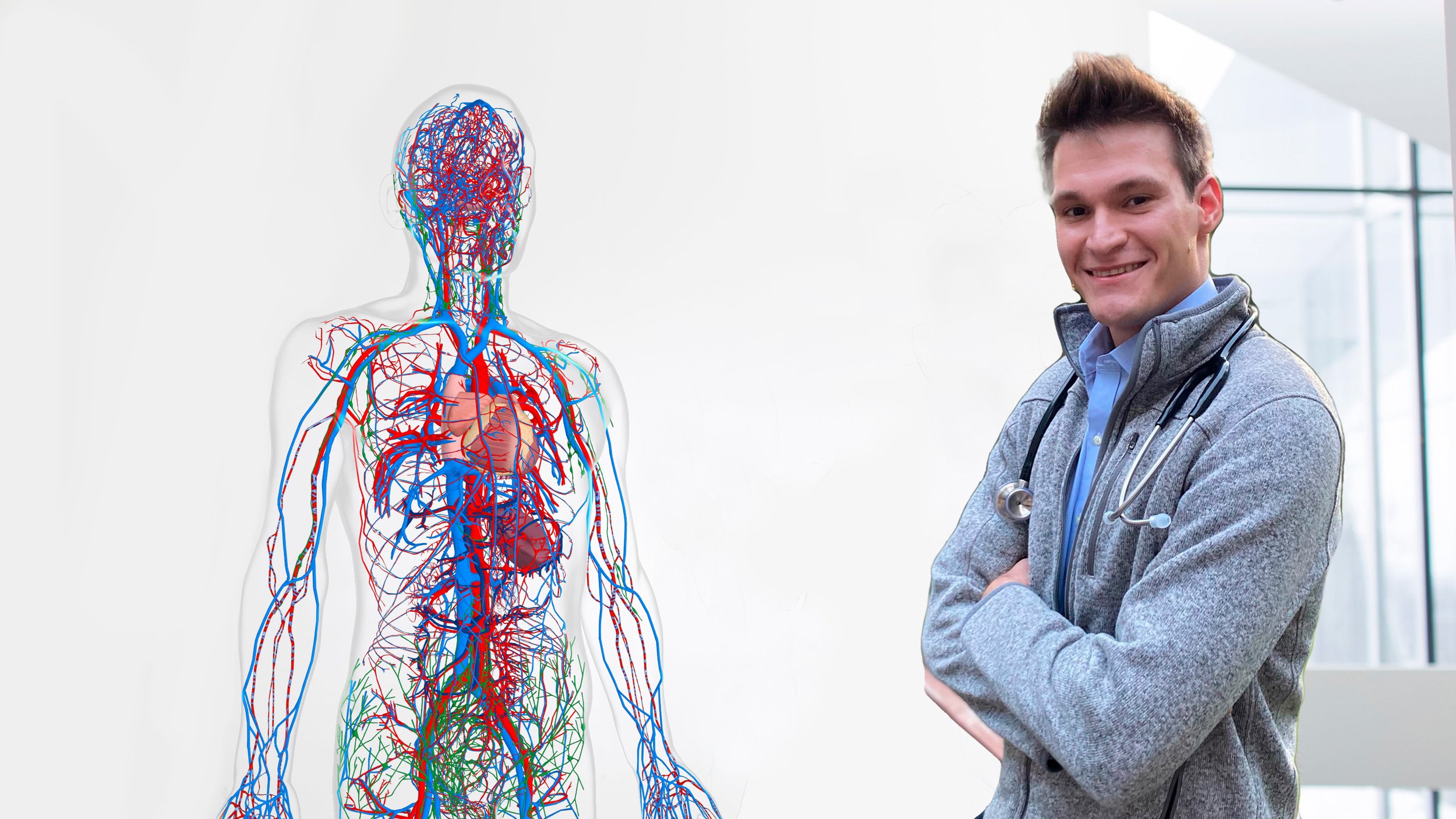Pioneers in Medical Education
CWRU M.D. candidate Ethan Winter with HoloAnatomy hologram
Ethan Winter, an M.D. candidate at Case Western Reserve University (CWRU), started medical school knowing next to nothing about anatomy.
“It was initially a subject I struggled with,” he remembers. “With chemistry and physics it’s all about understanding concepts, but with anatomy you have to understand the three-dimensional relationships between structures relationship between elements, and because I had no experience with anatomy at all, I found it very challenging.”
That is, until he experienced the HoloAnatomy® learning platform, which uses mixed-reality technology to illuminate the human body in three dimensions.
“Thanks to this software, anatomy became one of my favorite and strongest subjects,” Ethan says. “HoloAnatomy makes learning about the human body more accessible—something that can be tackled even by someone who’s completely new to the rigors of the medical school curriculum.”
“It enables you to take the anatomy from textbooks to something much more visual, 3D, and life-like,” according to Dr. Tom Cosker FRCS, former Director of Human Anatomy, University of Oxford. “It seems to ingrain itself in the student’s brain, and they will remember it for years to come.”
Ethan agrees: “HoloAnatomy played a huge part in my current desire to become a surgeon—I discovered I actually do like learning how the human body is constructed! This technology made anatomy extremely accessible and engaging, because you can build on your knowledge. You start with the basics, adding depth, context, and complexity only when you’re ready. Which in the end makes you a stronger, more competent student.”
Developed by CWRU, a leading light in global medical education, HoloAnatomy Software empowers students and educators to share detailed, immersive 3D visuals that enable collaborative exploration, either in-person or virtually from wherever there’s wi-fi, a mixed-reality headset, and HoloAnatomy software.
“You can be anywhere taking this course,” Ethan says. “HoloAnatomy can reach areas of the world where we need to bring medical education up to the level we have here.”
CWRU Associate Professor of Anatomy Sue Wish-Baratz, the anatomist who helped CWRU’s Interactive Commons develop the HoloAnatomy platform, describes the challenge of working with a cadaver: “In dissection, once something is cut, it’s gone and there’s no going back. First year medical students don’t know what they don’t know, and so they make mistakes you can’t unmake.”
HoloAnatomy, on the other hand, enables endless exploration without worrying about an errant snip ruining your learning experience.
“You come away with more certainty about what you’re seeing,” Ethan says. “With a cadaver, I struggled with the fact that everything is the same dull color, and you can’t choose to see just one group of muscles. You can’t isolate the aorta, for example, and then add layers, like the more minute branches of the aorta. In a cadaver it’s difficult to parse what’s important and what’s not.”
HoloAnatomy offers an idealized version of the body’s intricate, interconnected systems, with color coding to help students understand both structures and relationships.
“The colors help tremendously,” Ethan says. “In cadaver labs it can be difficult to distinguish things like arteries, nerves, and veins. As a beginner it’s just really challenging. With HoloAnatomy you can see all those things in different colors, as well as their relationships to muscles and bones, where they run, and how it all connects. You develop a much more thorough understanding of anatomy.”
Dr. Wish-Baratz explains that some structures simply aren’t visible in a cadaver dissection, such as lymphatics. “Anything that’s not big and obvious becomes incredibly hard to appreciate,” she says. “Especially for new students who have never seen these things before. That’s one of the ways HoloAnatomy bridges the gap between what you’re observing and how it relates to nearby structures.”
Ethan agrees: “When I went back to the cadaver lab, I was able to identify and understand much more having experienced it previously in holographic form.”
“HoloAnatomy is an incredible learning tool,” Ethan concludes. “To be able to enlarge systems and stand inside elements is amazing. You can duck underneath organs, look down from above—being able to see the body from all angles is a huge advantage, whereas in a cadaver lab it’s difficult and time consuming to move this heavy body around to try and see the same things.”
CWRU has long been a champion of collaborative learning. “Here at Case we’re huge on that,” Ethan says. “Our curriculum is built around the ability to bounce questions off each other. Students love to circle around the same holographic body—pursuing knowledge together is easier than doing it on your own. It’s a very uplifting environment.”
“I’m proud to be part of this institution,” Ethan concludes. “Proud that I go to such a great school, shaping the way medical education is done globally. Case was the first to pioneer this holographic approach to anatomy, and I was fortunate to be among the first to experience HoloAnatomy as a complete curriculum. I’m passionate about this learning platform, which is going to revolutionize the way anatomy is taught.”

